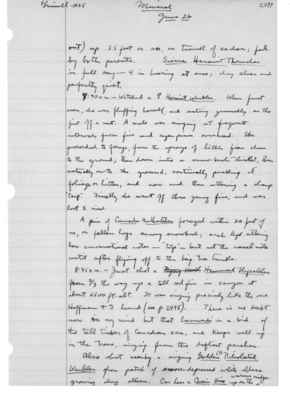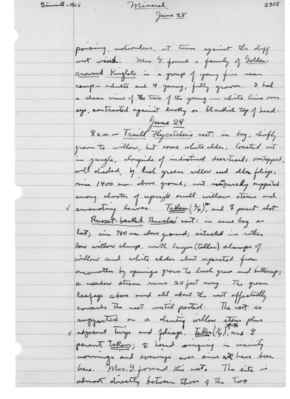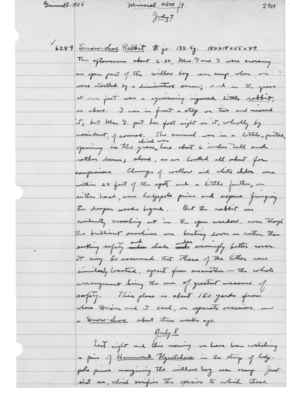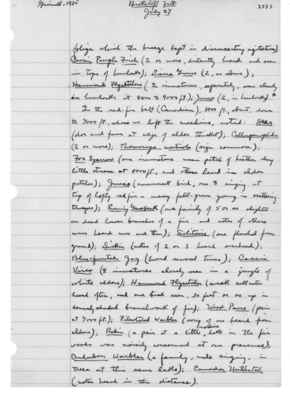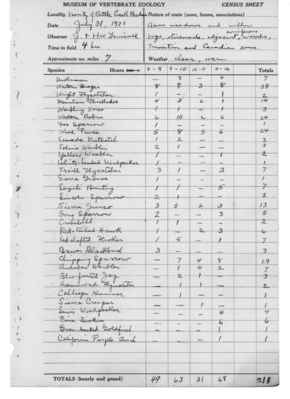Pages That Mention stream
1925: Joseph Grinnell's field notes
S2 Page 43
Collector: Grinnell - 1925 Location: Mineral Date: June 26 Page Number: 2497
out) up 35 feet or so, on trunk of cedar; fed by both parents. Sierra Hermit Thrushes in full song - 4 in hearing at once, day clear and perfectly quiet.
7:40 a.m. - Watched a [female symbol] Hermit Warbler. When first seen, she was fluffing herself, and attacking generally as tho just off a nest. A male was singing at frequent intervals from fir and sugar pines overhead. She proceeded to forage, from the sprays of little fir close to the ground; then down into a snow-bush thicket, then actually on to the ground, continually picking at foliage or litter, and now and then uttering a sharp "tsip." Finally she went off thru young firs, and was lost to view.
A pair of Canada Nuthatches foraged within 20 feet of us, on fallen logs among snowbush; each kept uttering low conversational notes "Tiys" - but not the nasal note until after flying off to the big tree trunks.
8:45 a.m. - Just shot a Pygmy Nuth Hammond Flycatcher from 2/3 the way up a all red fir in canyon at about 6500 ft. alt. It was singing precisely like the one Hoffmann & I heard (see p. 2495). There is no doubt now in my mind but that hammondi is a bird of the tall timber of Canadian zone, and keeps well up in trees, singing from the loftiest perches.
Also shot a singing Golden ^(?) Pileolated Warbler from batch of snow-depressed white alders growing along the stream. Can hear a Cassin Vireo up on the ^warmer ridge.
S2 Page 55
Collector: Grinnell - 1925 Location: Mineral Date: June 28 Page Number: 2508
poising, motionless, at times against the stiff west wind. Mrs. G. found a family of Golden crowned Kinglets in a group of young firs near camp - adults and 4 young, fully grown. I had a clear view of the two of the young - white line over eye, contrasted against dusky or blackish top of head.
June 29 8 a.m. - Traill Flycatcher's nest: in bog, chiefly grown to willow, but some white alder; located out in jungle, alongside of indistinct deer-trail; overtopped, well shaded, by lush green willow and older foliage; rim 1400 mm. above ground, nest insse^securely supported among cluster of upright small willow stems and emanating leaves. Taken (2/4)*, and [female symbol] parent shot.
Russet-backed Thrushes' nest: in same bog as last; rim 780 mm. above ground; situated in rather low willow clump, with larger (taller) clumps of willow and white alder about separated from one another by openings grown to lush grass and buttercup; a meadow stream runs 20 feet away. The green leafage above and all about the nest effectually conceals the nest until parted. The nest is supported on a slanting willow stem plus adjacent twigs and foliage. Taken (1/4)**, and [female symbol] parent taken; [male symbol] heard singing in vicinity mornings and evenings ever since we have been here. Mrs. G. found this nest. The site is almost directly between those of the two
S2 Page 71
Collector: Grinnell - 1925 Location: Mineral, 4800 ft. Date: July 7 Page Number: 2524
6289 Snow-shoe rabbit [male symbol] ju. 132.5 g. 180x18x55x49.
This afternoon about 2:30, Mrs. G and I were crossing an open part of the willow bog near camp, when we were startled by a diminutive stream; and in the grass at our feet was a squirming injured little rabbit, as above. I was in front a step or two and missed it; but Mrs. G. put her foot right on it, wholly by accident, of course The animal was in a little, parted opening in the grass ^which was here about 6 inches tall and rather dense; alone, as we looked all about for companions. Clumps of willow and white alder were within 25 feet of the spot; and a little farther, on either hand (?), were lodgepole pines and aspens fringing the deeper woods beyond. But the rabbit was evidently crouching out in the open meadow, even though the brilliant sunshine was beating down - rather than seeking safety underand shade andunder seemingly better cover. It may be assumed that others of the litter were similarly located, apart from one another - the whole arrangement being the one of greatest measure of safety. This place is about 150 yards from where Dixon and I each, on separate occasions, saw a Snow-shoe about three weeks ago.
July 8 Last night and this morning we have been watching a pair of Hammond Flycatchers in the strips of lodge pole pines margining the willow bog near camp. Just shot one, which verifies the species to which these
S2 Page 81
Collector: Grinnell - 1925 Location: Broke-off Mt. Date: July 27 Page Number: 2533
foliage which the breeze kept in disconcerting agitation); Cassin Purple Finch (2 or more, distantly heard and seen in tops of hemlocks); Sierra Grouse (2, as above); Hammond Flycatcher (2 immatures, separately, seen closely in hemlocks at 8000 to 9000 ft.); Junco (2, in hemlocks).*
In the red-fir belt (Canadian), 8000 ft., about, down to 7000 ft., where we left the machine, noted: Deer (doe and fawn at edge of alder thicket); Callospermophilus (2 or more); Thomomys monticola (sign common); Fox Sparrow (one immature near patch of heather along little stream at 8000 ft., and others heard in alder patches); Juncos (commonest bird, one [male symbol] singing at tip of lofty red fir - many full-grown young in scattering troupes); Evening Grosbeak (one family of 5 or so alighted on dead lower branches of a fir and notes of others were heard now and then); Solitaire (one flushed from ground); Siskin (notes of 2 or 3 heard overhead); Blue-fronted Jay (heard several times); Cassin Vireo (2 immatures closely seen in a jungle of white alders); Hammond Flycatcher (weak call notes heard often, and one bird seen, 30 feet or so up in densely shaded branchwork of fir); Wood Pewee (pair at 7000 ft.); Pileated Warbler (song of one heard from alders); Robin (a pair at a little ^moraine lake in the fir woods was noisily concerned at our presence); Audubon Warbler (a family, male singing, in trees at this same lake); Canada Nuthatch (notes heard in the distance).
S2 Page 86
| MUSEUM OF VERTEBRATE ZOOLOGY | CENSUS SHEET |
| Locality: Vicinity of Battle Creek Meadows | Nature of Route(zone,fauna, associations): |
| Date: July 31, 1925 | Across meadows and willow |
| Observer: J. & H.W. Grinnell | bogs, streamside, adjacent ^coniferous woods; |
| Time in Field: 4 hrs. | Transition and Canadian zones |
| Approximate no. miles: 7 | Weather: clear, warm |
| Species Hours[arrow symbol pointing right] | 8-9 | 9-10 | 10-11 | 11-12 | Totals | |
| Unknown | - | 3 | - | 4 | 7 | |
| Western Tanager | 8 | 9 | 3 | 8 | 28 | |
| Wright Flycatcher | 1 | - | - | 1 | 2 | |
| Mountain Chickadee | 4 | 3 | 6 | 1 | 14 | |
| Warbling Vireo | 1 | 1 | 0 | 1 | 3 | |
| Western Robin | 6 | 10 | 2 | 6 | 24 | |
| Fox Sparrow | 1 | 0 | 0 | 0 | 1 | |
| Wood Pewee | 5 | 8 | 5 | 6 | 24 | |
| Canada Nuthatch | 1 | 2 | 0 | 0 | 3 |
TOTALS (hourly and grand)|49|63|31|68|211
